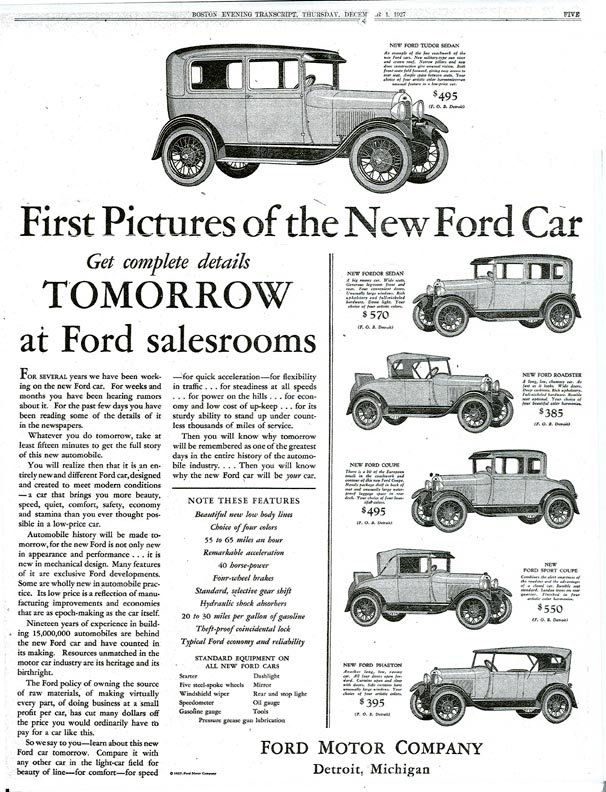 |
| Launching the new model with pictures of body styles. |
Henry Ford finally did
it. It was like pulling teeth and the
man who once revolutionized an industry and
put Americans behind to wheels of affordable automobiles was dragged into the wild new world of the Jazz Age and motorists with money burning
holes in their pockets. On December 2,
1927 Ford dealers began offering the brand new Model A replacing at long last 18 years of Model T production.
The
Tin Lizzie had been the most successful
automobile ever sold. Using Ford’s innovative
moving assembly line and a simple
design it had been marketed at prices that any reasonably middle class American could afford.
Autos were no longer the exclusive plaything of the rich. And as they
were produced year after year, millions of working
class and even poor citizen were
made mobile in second hand Flivers.
Ford
was loath to make changes. He was deep
in his heart a stubborn conservative. Moreover, he had peculiar ideas about the morality of automobile ownership. He regarded such things as color choices or personalized options offered by competitors as vanities. Of course his any-color-as-long-as-it’s-black philosophy also streamlined the
production process and kept the per unit price of his cars low. He considered innovations now common on
competitors like electronic ignition and
cabin heat in enclosed models as unnecessary frills. But the public was growing tired of breaking their arms trying to turn over
the Model T engine with a crank. They were also wearing of an engine that
by then was underpowered compared to other brands. It may have been fine with Ford, who was in
no hurry, by customers were tiring of a vehicle that could be passed by
anything else on wheels on the road including a determined milk wagon.
Sales
of the beloved Model T had been sinking as competitors, especially Chevrolet, matched Ford’s production innovations
and added some of their own. Chevy, and
the turncoat former Ford engineers
the Dodge Brothers were turning out
their own right-priced mass produced cars and were regularly updating them.
Ford’s
Board and his son Edsel finally convinced the old man it
was time for a change. Henry did not
make the transition, mostly overseen by Edsel, easy. He meddled in production maters—he tried to
convert from die stamping body parts
from sheet steel with more expensive
drop forge technology which not only
added production costs, but made the cars so heavy that even a new more
powerful engine could not produce more speed.
The idea had to be junked at the cost of millions. Edsel supervised the design which was much
more modern and slightly less boxy than the Model T. It was only after the new car was a success
that Henry pushed his son aside and took the credit for himself.
| New Model As on Edsel Ford's newly revamped assembly line at the giant River Rouge Plant in Dearborn, Michigan. |
Edsel
also tinkered with his father’s assembly line process, introducing flexible mass production, which allowed
individual units on the line to be individualized including the use of four
colors plus black and customer-ordered options.
The
car was powered by a new water-cooled
L-head 4-cylinder
engine that could produce cruising speeds
of 65 miles per hour. It also contained
industry innovations including the first use of shatter proof glass.
Six
body styles could be built on the basic Model A chassis plus variation of each—a Coupe, a Roadster, a Four Door Sedan, a Four Door Convertible, a Station
wagon or van, and a pick-up Truck. A simple Roadster could be had for as
little as $385 while a top-of-the-line Town
Car with all the options ran to $1,200,
not far below the price of luxury Cadillacs
and Packards.
In
the midst of the biggest economic boom in the country’s history, customers were
ready, willing, and able to buy and spend.
By February 1929, one million Model As had been sold, and by that July,
two million. Even with the Wall Street Crash that October and the
ensuing plunge into the Great Depression,
Ford was able to sell more than three million units domestically before the car
was taken out of production at the end of the 1932 model year. In no time at all in its various forms the
Model A was the most common sight on the road.
Henry
Ford had learned his lesson. He did not
become too attached to his new baby and replaced it in the 1933 model year with
still more modern Model B with available
with a flathead V-8 engine. And after the mid-30’s the company began
offering new models yearly.
The
model A became, largely because of its widespread availability, the car on
which the original hot rods were
built. It remains a starting point car
for many classic car restorers and
is still commonly customized. Both historically accurate restorations
and custom versions are common sights at car
shows and in local parades.
No comments:
Post a Comment